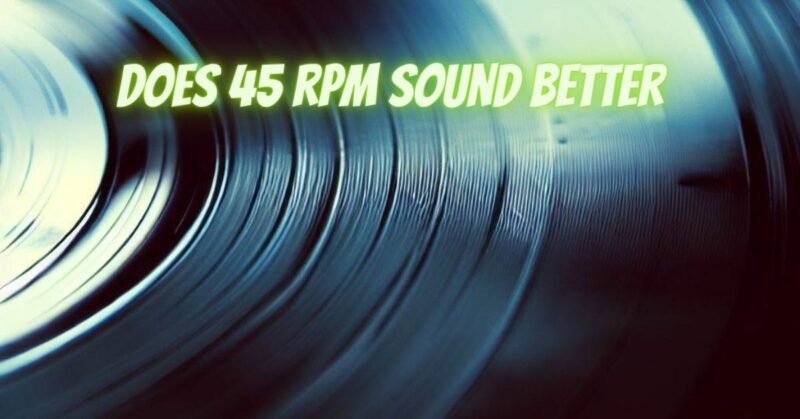In the realm of vinyl records, the debate over the optimal playback speed has long raged between proponents of 45 RPM (revolutions per minute) and 33⅓ RPM. While 33⅓ RPM has been the standard speed for vinyl records since the 1940s, 45 RPM has maintained a devoted following among audiophiles and music enthusiasts. At the heart of this debate lies the question of whether 45 RPM offers superior sound quality compared to its slower counterpart.
Understanding the Technical Differences
The primary difference between 45 RPM and 33⅓ RPM lies in the physical spacing of the grooves on the vinyl record. 45 RPM records have narrower grooves spaced closer together, while 33⅓ RPM records have wider grooves spaced farther apart. This difference in groove spacing directly impacts the amount of information that can be stored on the record.
Theoretical Advantages of 45 RPM
Due to their narrower grooves, 45 RPM records can accommodate more frequency information compared to 33⅓ RPM records. This translates to potentially better high-frequency response and a more detailed, nuanced sound. Additionally, the tighter groove spacing on 45 RPM records reduces the risk of tracking errors, which can cause audible distortion and affect overall sound quality.
Practical Considerations and Counterarguments
Despite the theoretical advantages of 45 RPM, there are practical considerations that may limit its perceived superiority in sound quality. Firstly, the shorter playing time of 45 RPM records (typically 5-10 minutes per side) necessitates more frequent record changes, potentially disrupting the listening experience.
Secondly, the higher rotational speed of 45 RPM records can increase wear and tear on both the record and the turntable stylus. This is particularly concerning with older vinyl records, which may be more susceptible to damage from the faster spinning speed.
Perceived Sound Quality vs. Actual Sound Quality
It’s important to distinguish between perceived sound quality and actual sound quality. Perceived sound quality is subjective and influenced by various factors, including individual listener preferences, listening environment, and the quality of the audio equipment.
Actual sound quality, on the other hand, is an objective measure based on the fidelity of the audio reproduction. Factors such as frequency response, dynamic range, and distortion levels contribute to the actual sound quality of a recording.
Blind Listening Tests and Expert Opinions
Blind listening tests, where listeners evaluate audio samples without knowing the playback speed, have yielded mixed results. Some studies have shown a slight preference for 45 RPM in terms of perceived sound quality, while others have found no significant difference between the two speeds.
Expert opinions on the matter also vary. Some audio engineers and mastering professionals maintain that 45 RPM offers superior sound quality, while others argue that the difference is negligible or even undetectable to most listeners.
The debate over whether 45 RPM offers superior sound quality is ultimately a matter of personal preference and listening context. For serious audiophiles seeking the ultimate in sonic fidelity, 45 RPM may offer a slight edge. However, for casual listeners who value convenience and longer playing times, 33⅓ RPM remains a perfectly viable choice.
The key lies in understanding the unique characteristics of each speed and selecting the one that best suits your individual preferences and listening habits. Whether you choose the dynamic intensity of 45 RPM or the extended listening experience of 33⅓ RPM, the joy of vinyl lies in the immersive, analog sound that continues to captivate music lovers worldwide.


